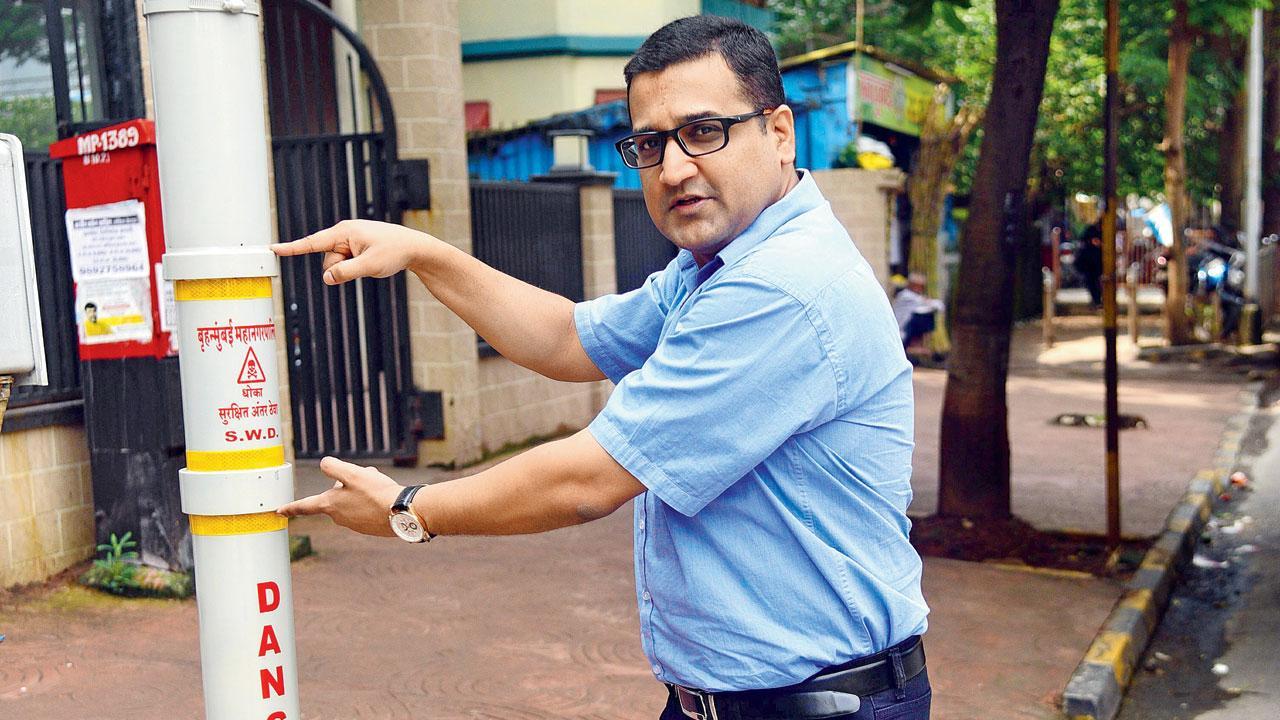Amateur weather analyst Ankur Puranik’s waterlogging detection device claims to end city’s monsoon woes

Engineer and amateur weather analyst Ankur Puranik has designed a smart waterlogging detection system called Flood-O-Meter, which he says can avoid resultant problems, including traffic snarls. The BMC has purchased the patented technology and has already installed 25 of these devices in the city. Pic/Pradeep Dhivar
Waterlogging is one of life’s certainties if you live in the city of dreams. Every year, the civic body conjures a new solution to the problem, and each year, the monsoons laugh at it. This time, Wadala-based entrepreneur and engineer Ankur Puranik, may win the match.
ADVERTISEMENT
The 41-year-old amateur weather analyst has designed Flood-O-Meter, an auto-activated waterlogging detection, measurement and reporting system. The portable device, 25 of which have already been installed in various spots such as Dadar’s Hindu Colony and Star Cinema in Mazagaon, can detect waterlogging and avoid resultant problems, including traffic snarls.
“It is a cylindrical device with a donut-shaped disk float, with a microcontroller attached to it,” Puranik explains. “It gets activated automatically as water accumulates. The disk floats up and down the cylinder as per the water level, the microcontroller reads the movement and sends data to the BMC [Brihanmumbai Municipal Corporation].”
This is space technology compared to the crude manual methods used by authorities currently. “Water is currently being measured in terms such as knee-deep, waist-level or chest-level,” says Puranik. “Some places have measuring scales, but the reading is in feet; this device measures in inches, giving an accurate picture.”
During heavy rainfall, BMC needs dynamic information on water level—how efficiently it’s draining away or whether the level is increasing dangerously. Puranik’s device does this. The civic body has purchased the patented technology for Rs 2.32 crore, including 100 devices, the dashboard and a contract for three-year maintenance. It is now confident of issuing necessary warnings, say alerting a school to remain shut, divert traffic or close a road.
“This device will help map water-logging in the entire city,” says Puranik. “The dashboard receives data at an interval of 15 minutes. This includes the time water accumulation began, the current level, the speed at which it is rising or receding, and location. This information is also available in the form of graphs, which analyse the time of the highest level, areas that need intervention, etc. Another window gives them measurement of rainfall in millimetres at the crucial location.” Hope is that this data can also be used by disaster management teams, meteorologists and scientists to study the annual problem in depth.
This isn’t Puranik’s first device. He has designed an automated weather station for the Railways and he also claims to have created the first made-in-India oxygen concentrator during the COVID-19 pandemic. The idea for the latest device struck him during the pandemic and from the depths of his own struggles during the monsoon season. “The problem is we don’t know what the level of water is, and whether we should take our car out or back,” he says. “When I searched for solutions online, I couldn’t find much. That led me to conceive a device that measures water level.”
For a living, Puranik designs, develops and manufactures equipment for the defence, Indian Railways, police, disaster management and the BMC. “For the Defence and police departments, we have made a portable lighting solution for operations in dimly-lit areas or in regions without electricity,” he says.
He developed the latest device within a year and by June 2021, filed for a patent. Its highlight, he says, is that it self-activates when water begins pooling in an area, saving manpower—to manually activate it—and power during the rest of the year. “I have used PVC for the cylinder and not iron that would rust,” he says, “Stainless steel would raise cost and seed the fear of being stolen. PVC makes it portable and compact. The entire unit weighs around 10 kg, and has a self-contained battery that can power the system for 50 flooded days, which is more than enough. On an average, waterlogging lasts four to 10 days.”
Puranik says he has received enquiries from other states, but is currently focusing on Mumbai. The next step would be to reach out to the Railways, as they too struggle with trains and passengers getting stranded in the middle of nowhere. But will it have the last word? With this year’s monsoon nearing its end, we’ll only find out next June.
 Subscribe today by clicking the link and stay updated with the latest news!" Click here!
Subscribe today by clicking the link and stay updated with the latest news!" Click here!







